AMD FX-8370E CPU Review: Vishera Down to 95W, Price Cuts for FX
by Ian Cutress on September 2, 2014 8:00 AM ESTCPU Benchmarks
The dynamics of CPU Turbo modes, with both Intel and AMD, can cause concern during environments with a variable threaded workload. There is also an added issue of the motherboard remaining consistent, depending on how the motherboard manufacturer wants to add in their own boosting technologies over the ones that Intel would prefer they used. In order to remain consistent, we implement an OS-level unique high performance mode on all the CPUs we test which should override any motherboard manufacturer performance mode.
HandBrake v0.9.9: link
For HandBrake, we take two videos (a 2h20 640x266 DVD rip and a 10min double UHD 3840x4320 animation short) and convert them to x264 format in an MP4 container. Results are given in terms of the frames per second processed, and HandBrake uses as many threads as possible.
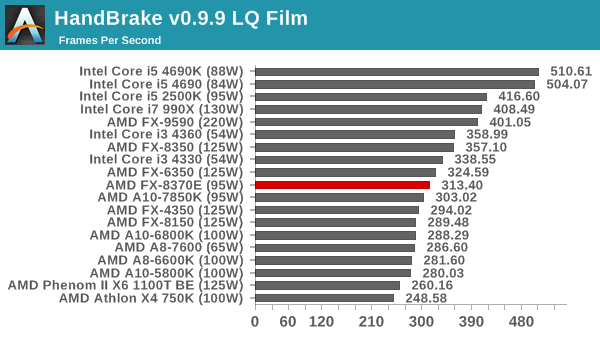
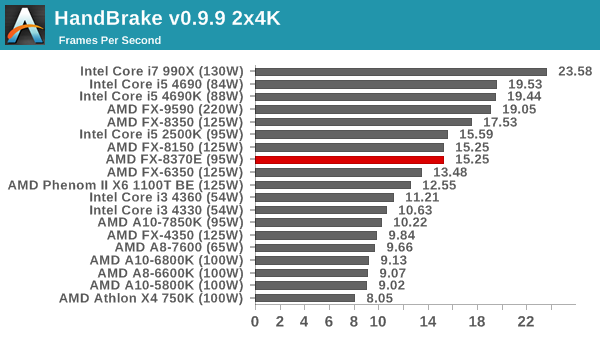
Handbrake balances cores and frequency, with the LQ film test often condensing CPUs based on frequency and the double UHD test expanding by cores. The double UHD test puts the 8370E at the bottom of the AMD 8-thread CPUs as expected.
Agisoft Photoscan – 2D to 3D Image Manipulation: link
Agisoft Photoscan creates 3D models from 2D images, a process which is very computationally expensive. The algorithm is split into four distinct phases, and different phases of the model reconstruction require either fast memory, fast IPC, more cores, or even OpenCL compute devices to hand. Agisoft supplied us with a special version of the software to script the process, where we take 50 images of a stately home and convert it into a medium quality model. This benchmark typically takes around 15-20 minutes on a high end PC on the CPU alone, with GPUs reducing the time.
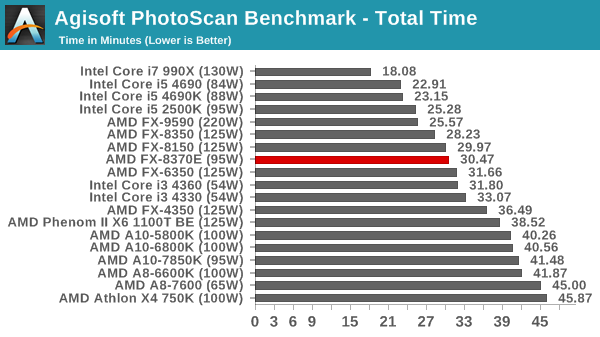
Photoscan results seem to take the following order: i7, i5, FX (8), FX (6), i3, FX (4), A10, A8. The 8370E sits at the bottom of the FX 8-thread section as before.
WinRAR 5.0.1: link

WinRAR takes advantage of all the AMD threads due to its integer workloads.
PCMark8 v2 OpenCL
A new addition to our CPU testing suite is PCMark8 v2, where we test the Work 2.0 and Creative 3.0 suites in OpenCL mode. As this test is new, we have not run it on many AMD systems yet and will do so as soon as we can.

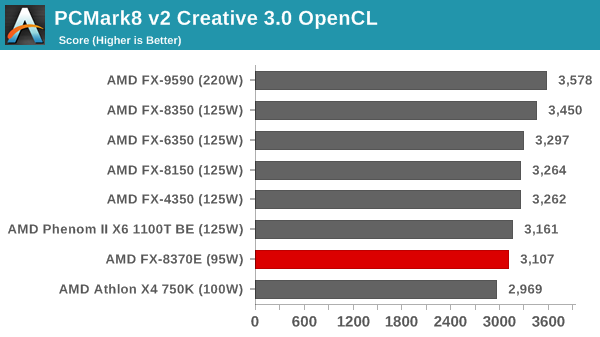
The PCMark8 tests both seem to favor frequency at this point, with the FX-9590 taking the lead.
Hybrid x265
Hybrid is a new benchmark, where we take a 4K 1500 frame video and convert it into an x265 format without audio. Results are given in frames per second.
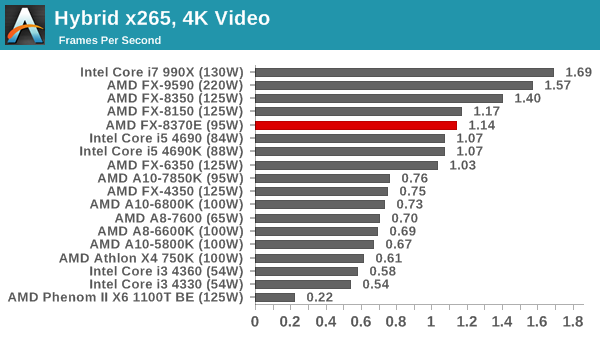
Again, more threads gives an intesting workload. The FX-8370E beats out the i5-4690K as well.
Cinebench R15
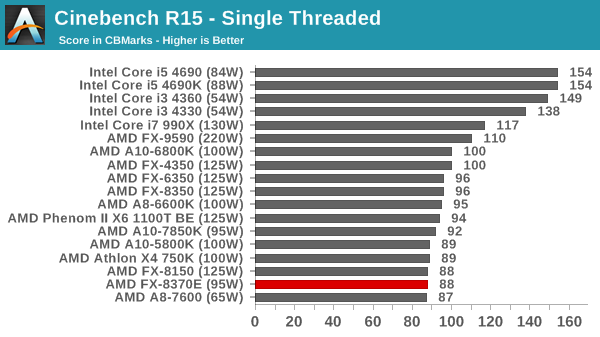

Unfortunately the Achilles heel strikes again in single threaded performance. Multithreaded puts it just behind the FX-8150.
3D Particle Movement
3DPM is a self-penned benchmark, taking basic 3D movement algorithms used in Brownian Motion simulations and testing them for speed. High floating point performance, MHz and IPC wins in the single thread version, whereas the multithread version has to handle the threads and loves more cores.

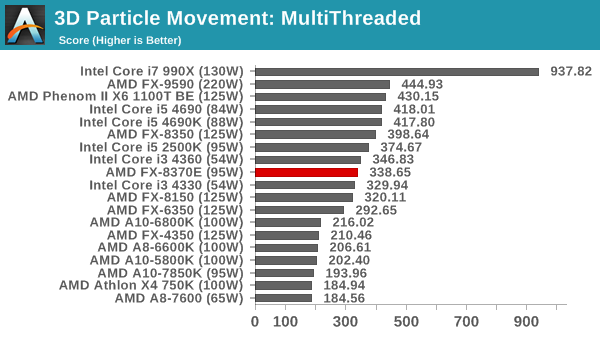
FastStone Image Viewer 4.9
FastStone is the program I use to perform quick or bulk actions on images, such as resizing, adjusting for color and cropping. In our test we take a series of 170 images in various sizes and formats and convert them all into 640x480 .gif files, maintaining the aspect ratio. FastStone does not use multithreading for this test, and results are given in seconds.
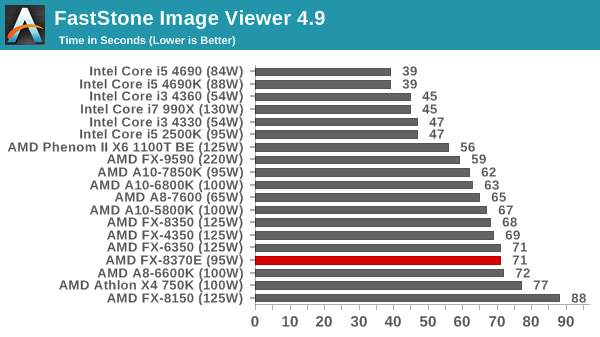
Web Benchmarks
On the lower end processors, general usability is a big factor of experience, especially as we move into the HTML5 era of web browsing. For our web benchmarks, we take four well known tests with Chrome 35 as a consistent browser.
Sunspider 1.0.2
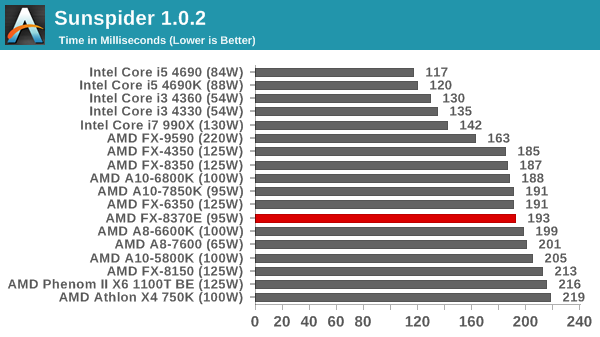
Mozilla Kraken 1.1
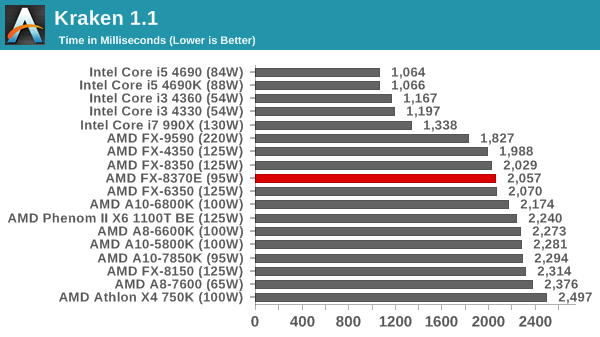
WebXPRT
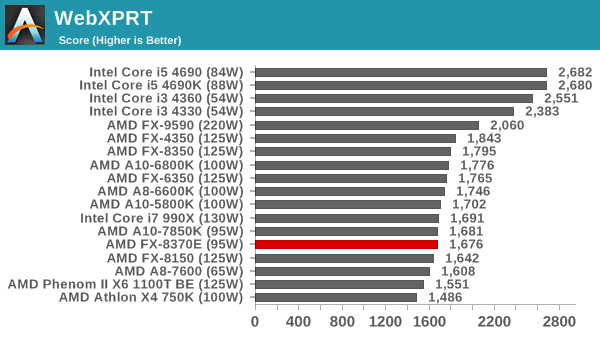
Google Octane v2
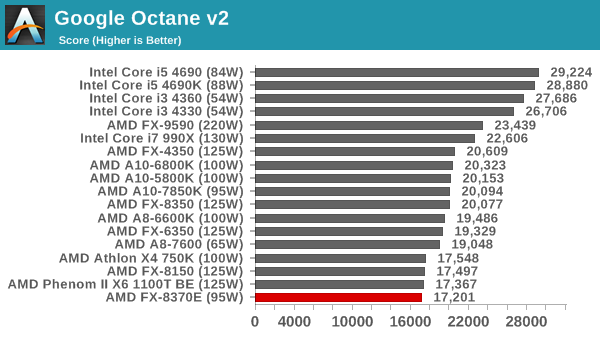










107 Comments
View All Comments
Vayra - Saturday, September 13, 2014 - link
It is not just Intel's fault though. AMD's marketing and timing is notoriously bad and has been for a long time. And they still keep fucking it up. Remember Mantle? Any other company would have been cashing in on that performance advantage, bigtime, even if it was only a couple percent. The only things that help AMD sales are factors beyond their control such as the sales bump on their GPU's when Bitcoin mining became popular.SunLord - Wednesday, September 3, 2014 - link
I doubt will see anything worthwhile from AMD let alone something that touches i7 until K12 ships. I can see them refreshing the FX chips next year using steamroller or a follow on core namely one that hopefully involves mostly 65W processors with 95w being the tdphescominsoon - Friday, October 17, 2014 - link
AMD isn't going to be able to get even with Intel(much less get ahead of them) until they move away form this two alu and 1 fpu per module garbage. The first gen Athlon has Intel running scared. All AMD can do now is compete on price..and they aren't doing that very well either. AMD is now facing what Intel was facing during the P-4 days. Hotter cpus that don't perform many things as well as the competition. AMD is a solid 2 generations behind in nearly all areas right now and with this current design they won't catch up.bebimbap - Tuesday, September 2, 2014 - link
searching on the net it seems the 8370 and the 8370e both OC the same. without the power limits it seems 4.7-5.0ghz for 1.45v is average for this cpu. so expect about a 20-25% OCability if your motherboard can supply enough powerif power/temps are not an issue one site even suggested the 8350 the better value buy.
though from the data it seems at the same voltage and same MHz the 8370e is much lower in temps compared to the 8350. could just be good chip lotto.
Sigh, i miss the old thoroughbred days.
Knowname - Monday, September 15, 2014 - link
my FM2 A10-7850 is twice as fast as my old Phenom x3 and it didn't cost much to upgrade even if it meant a whole new mobo. I'd no doubt go this route over an incremental upgrade using the old vishera design. My old Phenom x3 was AM2+ though, might want to double check your motherboard, if it IS just AM2+ you may have no choice! But have no fear, it is quite a bit snappier if you just go with the AMD APU. In fact if your uninterested in Mantle I'd just go with an old Trinity/ Richland design!Scionero - Saturday, December 27, 2014 - link
I know this is an old discussion but recent prices make this situation different. An Intel I5-4690k will almost always beat out an AMD 8370E, for example. But the AMD will be about 80% as powerful as the I5 at 60% of the price. If you need every last bit of processing power then go for the Intel CPU's, but for me the AMD is the clear winner for everyday tasks and gaming.blackmagnum - Tuesday, September 2, 2014 - link
Does this AMD chip have anything to do with this?: August 29th, The Haswell-E Launch.boot318 - Tuesday, September 2, 2014 - link
AMD doesn't even belong in the same sentence/paragraph/write-up/world/etc with that processor line. No, to answer your question. AMD is improving the power consumption of CPUs they already have out (3 years old now). Timing is just an coincidence with Intel's new Haswell-E launch.just4U - Tuesday, September 2, 2014 - link
Maybe.. but AMD gets a lot of criticism for it's power hungry processors so it's nice to see this get bumped down to 95watts. Intel's new line has 125watt cpu's which pretty much got a free pass in reviews. I found that odd.. especially with my 4790K coming in at 88watts.TiGr1982 - Tuesday, September 2, 2014 - link
I just bought and installed 4790K in my own Z87 desktop. The thing is that these 88 W in case of Intel are a typical, but not a very peak CPU wattage; e.g., my 4790K at 4.4 GHz on all the cores at 1.225 V consumes around 115 W in CPU-heavy tasks like Prime95 AVX 8 threads.So, take these 88 W "with a grain of salt".